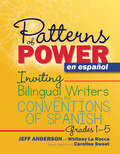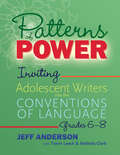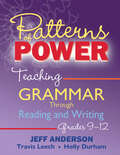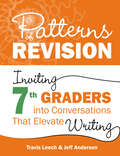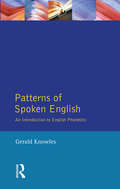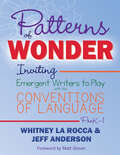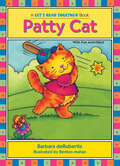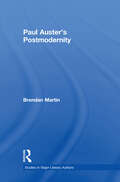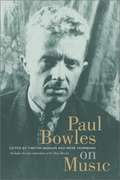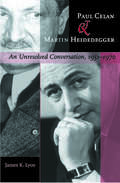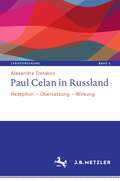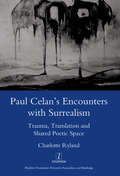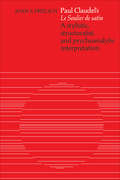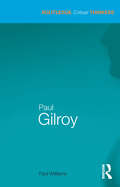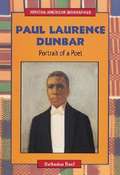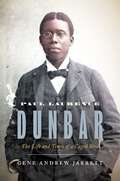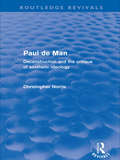- Table View
- List View
Patterns of Power en español, Grades 1-5: Inviting Bilingual Writers into the Conventions of Spanish (Patterns of Power)
by Jeff Anderson Whitney La Rocca Caroline SweetAuthor Jeff Anderson and bilingual teacher and coach Caroline Sweet lead a vibrant approach to grammar instruction in Patterns of Power en español, Grades 1-5: Inviting Bilingual Writers into the Conventions of Spanish. Here, young, emergent writers are invited to notice the conventions of the Spanish language and build off them in this inquiry-based approach to instructional grammar. The book comes with standards-aligned lessons that can be incorporated in just 10 minutes a day. Patterns of Power’s responsive, invitational approach puts students in an involved role and has them explore and discuss the purpose and meaning of what they read. Students study short, authentic texts and are asked to share their findings out loud, engaging in rich conversations to make meaning. Inside you’ll find: Ready-to-use lesson plan sets that include excerpts from authentic and diverse Spanish mentor texts curated for grades 1-5 and can be adapted over 5 grade levels Real-life classroom examples, tips, and Power Notes gleaned from the authors’ experiences that can be applied to any level of writer Resources, including a Patterns of Power Planning Guide adapted for Spanish, to use in classroom instruction or as handouts for student literacy notebooks How to correlate to Spanish TEKS, Common Core, and other state standards Patterns of Power en español, Grades 1-5 provides a simple classroom routine that is structured in length and approach, but provides teachers flexibility in choosing the texts, allowing for numerous, diverse voices in the classroom. The practice helps students build cognitive recognition and provides a formative assessment for teachers on student progress. With these short lessons, students will gain confidence and move beyond limitation to produce effortless writing in your class and beyond. The Patterns of Power series also includes Patterns of Power, Grades 6-8: Inviting Adolescent Writers into the Conventions of Language; Patterns of Power, Grades 1-5: Inviting Young Writers into the Conventions of Language; Patterns of Power, Grades 9-12: Teaching Grammar Through Reading and Writing; and Patterns of Wonder, Grades PreK-1: Inviting Emergent Writers to Play with the Conventions of Language.
Patterns of Power, Grades 1-5: Inviting Young Writers into the Conventions of Language (Patterns of Power)
by Jeff Anderson Whitney La RoccaAuthor Jeff Anderson and literacy coach Whitney La Rocca lead a vibrant approach to grammar instruction in Patterns of Power, Grades 1-5: Inviting Young Writers into the Conventions of Language. Here, young, emergent writers are invited to notice the conventions of the English language and build off them in this inquiry-based approach to instructional grammar. The book comes with standards-aligned lessons that can be incorporated in 10 minutes a day. Patterns of Power’s responsive, invitational approach puts students in an involved role and has them explore and discuss the purpose and meaning of what they read. Students study short, authentic texts and are asked to share their findings out loud, engaging in rich conversations to make meaning. Inside you’ll find: Ready-to-use lesson plan sets that include excerpts from authentic and diverse mentor texts curated for grades 1-5 and can be adapted over 5 grade levels Real-life classroom examples, tips, and Power Notes gleaned from the authors’ experiences that can be applied to any level of writer Resources, including a Patterns of Power Planning Guide and musical soundtracks, to use in classroom instruction or as handouts for student literacy notebooks Patterns of Power, Grades 1-5 provides a simple classroom routine that is structured in length and approach, but provides teachers flexibility in choosing the texts, allowing for numerous, diverse voices in the classroom. The practice helps students build cognitive recognition and provides a formative assessment for teachers on student progress. With these short lessons, students will grow their confidence and move beyond limitation to produce effortless writing in your class and beyond. The Patterns of Power series also includes Patterns of Power, Grades 6-8: Inviting Adolescent Writers into the Conventions of Language; Patterns of Power en Español, Grades 1-5: Inviting Bilingual Writers into the Conventions of Spanish; Patterns of Power, Grades 9-12: Teaching Grammar Through Reading and Writing and Patterns of Wonder, Grades PreK-1: Inviting Emergent Writers to Play with the Conventions of Language.
Patterns of Power, Grades 6–8: Inviting Adolescent Writers into the Conventions of Language (Patterns of Power)
by Jeff Anderson Travis Leech Melinda ClarkAuthors Jeff Anderson, Travis Leech, and Melinda Clark lead a vibrant approach to grammar instruction in Patterns of Power, Grades 6-8: Inviting Adolescent Writers into the Conventions of Language. Here, young, emergent writers are invited to notice the conventions of the English language and build off them in this inquiry-based approach to instructional grammar. The book comes with standards-aligned lessons that can be incorporated in just 10 minutes a day. Patterns of Power’s responsive, invitational approach puts students in an involved role and has them explore and discuss the purpose and meaning of what they read. Students study short, authentic texts and are asked to share their findings out loud, engaging in rich conversations to make meaning. Inside you’ll find: Ready-to-use lesson plan sets that include excerpts from authentic and diverse mentor texts curated for grades 6-8 Real-life classroom examples, tips, and Power Notes gleaned from the authors’ experiences that can be applied to any level of writer Resources, including a Patterns of Power Planning Guide and musical soundtracks, to use in classroom instruction or as handouts for student literacy notebooks Patterns of Power, Grades 6-8 provides a simple classroom routine that is structured in length and approach, but provides teachers flexibility in choosing the texts, allowing for numerous, diverse voices in the classroom. The practice helps students build cognitive recognition and provides a formative assessment for teachers on student progress. With these short lessons, students will gain confidence and move beyond limitation to produce effortless writing in your class and beyond. The Patterns of Power series also includes Patterns of Power, Grades 1-5: Inviting Young Writers into the Conventions of Language; Patterns of Power en Español, Grades 1-5: Inviting Bilingual Writers into the Conventions of Spanish; Patterns of Power, Grades 9-12: Teaching Grammar Through Reading and Writing; and Patterns of Wonder, Grades PreK-1: Inviting Emergent Writers to Play with the Conventions of Language.
Patterns of Power, Grades 9-12: Teaching Grammar Through Reading and Writing
by Jeff Anderson Travis Leech Holly DurhamTraditional grammar instruction often focuses too much on what’s right or what’s wrong, hiding the true power of conventions—the creation of meaning, purpose, and effect. Instead of hammering high school students with the mistakes they should avoid, Jeff Anderson, Travis Leech, and Holly Durham suggest exploring grammar through the celebration of author’s purpose and craft. In Patterns of Power, Grades 9-12: Teaching Grammar Through Reading and Writing, they invite you to create an environment in which writers thrive while studying and appreciating the beauty, effects, and meaning of grammar. Inside this book, teachers will find a comprehensive explanation of the brain-based Patterns of Power invitational process, as well as: 35 standards-aligned lesson sets built around practical, engaging, inquiry-based methods that take deeper dives into grammar and craft than any worksheet, quiz, or editing exercise ever could A variety of high-interest model texts from authentic and diverse sources, including excerpts from classic and current novels, memoirs, plays, graphic novels, poems, and media Real-life classroom examples and tips with suggestions for scaffolding new learning and ideas for how to use the lessons in AP courses Templates for extended application, easy to locate printables, and ready-to-go visuals Additional Models for Further Study for extension opportunities in every lesson set An entire chapter devoted to helping high school writers master citations in research With hundreds of teach-tomorrow resources and implementation supports such as quick-reference guides, specific applications to reading instruction, and soundtrack suggestions to infuse the joy of music into grammar instruction, Patterns of Power, Grades 9-12 gives you everything you need to inspire your high school writers to move beyond limitation and into the endless possibilities of what they can do as writers. The Patterns of Power series also includes Patterns of Power, Grades 6-8: Inviting Adolescent Writers into the Conventions of Language; Patterns of Power, Grades 1-5: Inviting Young Writers into the Conventions of Language; Patterns of Wonder, Grades PreK-1: Inviting Emergent Writers to Play with the Conventions of Language; and Patterns of Power en Español, Grades 1-5: Inviting Bilingual Writers into the Conventions of Spanish.
Patterns of Religious Narrative in the Canterbury Tales (Routledge Library Editions: Chaucer)
by Roger EllisOriginally published in 1986. This study asks ‘What problems confront the narrator of a religious story?’ and ‘What different solutions to those problems are offered by the religious narratives of The Canterbury Tales?’ The introduction explains the grounds for inclusion of the tales here studied then examined in three sections. The first includes the tales of the Clerk, Prioress and Second Nun, and Chaucer’s Melibee, and explores the parallels between the production of a religious narrative and that of a faithful translation. The second considers how the tales of the Man of Law, Monk and Physician, though formally similar to those in the first section, subvert the offered parallel by their creation of narrators who actively mediate them to their audience, and who seem as concerned with the projection of their own personalities as with the transmission of the given story. The final section shows how the tales of the Pardoner and Nun’s Priest highlight the dilemma and provide distinctive resolutions. The whole study aims to explore the dynamic relationships that exist between two contrasting positions: an artist’s commitment to the authority of a given story and his need to assert himself over it.
Patterns of Revision, Grade 6: Inviting 6th Graders into Conversations That Elevate Writing
by Jeff Anderson Travis LeechHow do we get sixth-grade writers to revise? And once we do get them thinking about revision, what, exactly, do they do? What do we do? In Patterns of Revision, best-selling authors Travis Leech and Jeff Anderson answer these questions and more. This practical resource uses the research-proven and classroom-tested methods of sentence combining in a meaningful, engaging way that supports authentic writing as well as performance-based or multiple-choice test items.Flip the book open to immediately find: The DRAFT mnemonic to help students know where to begin the revision process and how to keep going Concrete, doable lessons that spark academic conversations about meaning, effect, and purpose that are grounded in a student-centered revision approach Easily accessed displays and printables to seamlessly support student revision learning, embedded in each lesson right where you need it Authentic and engaging model text excerpts curated to support each lesson An engaging process for revision instruction that can be immediately implemented to support any writing approach, or as a supplemental resource for Patterns of Power, 6-8 With every lesson grounded in the critical strategy of writers talking out their revisions, Patterns of Revision will establish routines, practices, and mindsets to set you and your students up for success from day one. Discover the joy inherent in writing—and writing instruction—when we explore revision through engaging inquiry and the study of models, building flexible, competent revisors, step-by-step, in an open-ended discussion of meaning-driven revision choices and their effects.
Patterns of Revision, Grade 7: Inviting 7th Graders into Conversations That Elevate Writing
by Jeff Anderson Travis LeechHow do we get seventh-grade writers to revise? And once we do get them thinking about revision, what, exactly, do they do? What do we do? In Patterns of Revision, best-selling authors Travis Leech and Jeff Anderson answer these questions and more. This practical resource uses the research-proven and classroom-tested methods of sentence combining in a meaningful, engaging way that supports authentic writing as well as performance-based or multiple-choice test items.Flip the book open to immediately find: The DRAFT mnemonic to help students know where to begin the revision process and how to keep going. Concrete, doable lessons that spark academic conversations about meaning, effect, and purpose that are grounded in a student-centered revision approach. Easily accessed displays and printables to seamlessly support student revision learning, embedded in each lesson right where you need it. Authentic and engaging model text excerpts curated to support each lesson. An engaging process for revision instruction that can be immediately implemented to support any writing approach, or as a supplemental resource for Patterns of Power, 6-8. With every lesson grounded in the critical strategy of writers talking out their revisions, Patterns of Revision will establish routines, practices, and mindsets to set you and your students up for success from day one. Discover the joy inherent in writing—and writing instruction—when we explore revision through engaging inquiry and the study of models, building flexible, competent revisors, step-by-step, in an open-ended discussion of meaning-driven revision choices and their effects.
Patterns of Revision, Grade 8: Inviting 8th Graders into Conversations That Elevate Writing
by Jeff Anderson Travis LeechHow do we get eighth-grade writers to revise? And once we do get them thinking about revision, what, exactly, do they do? What do we do? In Patterns of Revision, best-selling authors Travis Leech and Jeff Anderson answer these questions and more. This practical resource uses the research-proven and classroom-tested methods of sentence combining in a meaningful, engaging way that supports authentic writing as well as performance-based or multiple-choice test items.Flip the book open to immediately to find: The DRAFT mnemonic to help students know where to begin the revision process and how to keep going. Concrete, doable lessons that spark academic conversations about meaning, effect, and purpose that are grounded in a student-centered revision approach. Easily accessed displays and printables to seamlessly support student revision learning, embedded in each lesson right where you need it. Authentic and engaging model text excerpts curated to support each lesson. An engaging process for revision instruction that can be immediately implemented to support any writing approach, or as a supplemental resource for Patterns of Power, 6-8. With every lesson grounded in the critical strategy of writers talking out their revisions, Patterns of Revision will establish routines, practices, and mindsets to set you and your students up for success from day one. Discover the joy inherent in writing—and writing instruction—when we explore revision through engaging inquiry and the study of models, building flexible, competent revisors, step-by-step, in an open-ended discussion of meaning-driven revision choices and their effects.
Patterns of Spoken English: An Introduction to English Phonetics (Learning about Language)
by Gerald KnowlesFirst published in 1987. Routledge is an imprint of Taylor & Francis, an informa company.
Patterns of Wonder, Grades PreK-1: Inviting Emergent Writers to Play with the Conventions of Language
by Jeff Anderson Whitney La RoccaWhitney La Rocca and Jeff Anderson adapt their vibrant approach to grammar instruction in Patterns of Wonder, Grades Prek-1: Inviting Emergent Writers to Play with the Conventions of Language. Here, young, emergent writers are invited to notice the conventions of language and build off them in this inquiry-based approach to instructional grammar. The book comes with standards-aligned lessons that can be incorporated in just 10 minutes a day. Patterns of Wonder’s responsive, invitational approach allows young students to play and inquire about language and experiment, take risks, and have fun. Inside you’ll find: Ready-to-use lesson plan sets that pinpoint and build across the most common needs of emergent writers An adjusted invitational process adapted for young learners, and the Phases of Emergent Writing as tools to plan for effective, scaffolded instruction How to position grammar concepts about print instruction across three overlapping levels of support: oral language, illustrating, and writing Over 200 engaging picture book recommendations to stir curious classroom conversations Patterns of Wonder, Grades PreK-1 provides a simple classroom routine that is structured in length and approach, but provides teachers flexibility in choosing the texts, allowing for numerous, diverse voices in the classroom. The practice helps students build cognitive recognition and provides a formative assessment for teachers on student progress. Grounded in play, conversation, and most of all, wonder, Patterns of Wonder brings the authors’ irrepressible excitement for inquiry and writing instruction to the ways we support our Pre-K, Kindergarten and 1st grade emergent writers. The Patterns of Power series also includes Patterns of Power, Grades 6-8: Inviting Adolescent Writers into the Conventions of Language; Patterns of Power, Grades 1-5: Inviting Young Writers into the Conventions of Language; Patterns of Power, Grades 9-12: Teaching Grammar Through Reading and Writing; and Patterns of Power en Español. Grades 1-5: Inviting Bilingual Writers into the Conventions of Spanish.
Patty Cat: Short Vowel A (Let's Read Together ®)
by Barbara deRubertisLet&’s Read Together books merge rhyme and vowel sounds in delightfully zany stories kids will want to read again and again. Each of the 15 books in this classic series by award-winning author/educator Barbara deRubertis will give your child a jumpstart on reading success."Story lines are silly and inventive, and recall Dr. Seuss&’s Cat in the Hat for the building of rhythm and rhyming words." —School Library JournalPatty Cat wants to play ball, but Max the Rat has stolen the bat! (This easy-to-read story features the short &“a&” vowel sound.)
Paul Auster's Postmodernity (Studies in Major Literary Authors)
by Brendan MartinThis book focuses upon the literary and autobiographical writings of American novelist Paul Auster, investigating his literary postmodernity in relation to a full range of his writings. Martin addresses Auster’s evocation of a range of postmodern notions, such as the duplicitous art of self-invention, the role of chance and contingency, authorial authenticity and accountability, urban dislocation, and the predominance of duality.
Paul Bowles on Music
by Paul Bowles Timothy Mangan Irene HerrmannThis volume collects the music criticism Bowles published between 1935 and 1946, with an interview conducted by Irene Herrmann shortly before his death.
Paul Celan and Martin Heidegger: An Unresolved Conversation, 1951–1970
by James K. LyonThis work explores the troubled relationship and unfinished intellectual dialogue between Paul Celan, regarded by many as the most important European poet after 1945, and Martin Heidegger, perhaps the most influential figure in twentieth-century philosophy. It centers on the persistent ambivalence Celan, a Holocaust survivor, felt toward a thinker who respected him and at times promoted his poetry. Celan, although strongly affected by Heidegger's writings, struggled to reconcile his admiration of Heidegger's ideas on literature with his revulsion at the thinker's Nazi past. That Celan and Heidegger communicated with each other over a number of years, and in a controversial encounter, met in 1967, is well known. The full duration, extent, and nature of their exchanges and their impact on Celan's poetics has been less understood, however. In the first systematic analysis of their relationship between 1951 and 1970, James K. Lyon describes how the poet and the philosopher read and responded to each other's work throughout the period. He offers new information about their interactions before, during, and after their famous 1967 meeting at Todtnauberg. He suggests that Celan, who changed his account of that meeting, may have contributed to misreadings of his poem "Todtnauberg." Finally, Lyon discusses their two last meetings after 1967 before the poet's death three years later. Drawing heavily on documentary material—including Celan's reading notes on more than two dozen works by Heidegger, the philosopher's written response to the poet's "Meridian" speech, and references to Heidegger in Celan's letters—Lyon presents a focused perspective on this critical aspect of the poet's intellectual development and provides important insights into his relationship with Heidegger, transforming previous conceptions of it.
Paul Celan in Russland: Rezeption – Übersetzung – Wirkung (Lyrikforschung. Neue Arbeiten zur Theorie und Geschichte der Lyrik #2)
by Alexandra TretakovPaul Celans Status in Russland hat sich in den letzten zwei Jahrzehnten stark verändert: Von einem Autor, der noch in den 1990er-Jahren bloß in literarischen Kreisen bekannt war, ist er zu einer Figur des breiten künstlerischen Kanons geworden. Dabei ist die russische Übersetzungslandschaft in Bezug auf Celan von Pluralität geprägt. An diese Beobachtung knüpft die vorliegende Studie an: Sie befasst sich mit den unterschiedlichen Übersetzungsstrategien der russischsprachigen ‚Dichterinnen-Übersetzerinnen‘ Ol’ga Sedakova und Anna Glazova sowie Aleša Prokop’evs. Im Anschluss daran wird Celans poetische und poetologische Wirkung auf ihr eigenes dichterisches Werk untersucht sowie die Bedeutung der kabbalistischen Numerik in Celans Gedichten herausgearbeitet.
Paul Celan's Encounters with Surrealism: Trauma, Translation and Shared Poetic Space
by Charlotte Ryland"Paul Celan (1920-1970), one of the most important and challenging poets in post-war Europe, was also a prolific and highly idiosyncratic translator. His post-Holocaust writing is inextricably linked to the specific experiences that have shaped contemporary European and American identity, and at the same time has its roots in literary, philosophical and scientific traditions that range across continents and centuries surrealism being a key example. Celan's early works emerge from a fruitful period for surrealism, and they bear the marks of that style, not least because of the deep affinity he felt with the need to extend the boundaries of expression. In this comparative and intertextual study, Charlotte Ryland shows that this interaction continued throughout Celans lifetime, largely through translation of French surrealist poems, and that Celans great oeuvre can thus be understood fully only in the light of its interaction with surrealist texts and artworks, which finally gives rise to a wholly new poetics of translation. Charlotte Ryland is Lecturer in German at St Hughs College and The Queens College, Oxford."
Paul Claudel's 'Le Soulier de satin': A Stylistic, Structuralist, and Psychoanalytic Interpretation
by Joan S. FreilichClaudel's most important work, Le Soulier de satin, has confused and puzzled readers since it first appeared. Joan S. Freilich's intensive examination of Claudel's imagery combined stylistic , structuralist, and psychoanalytic analyses. These are new methods that have been developed over the past two decades and are based on an examination of the text from the reader's point of view. This is a radical break with conventional literary studies which examine literature biographically or comparatively, i.e., focusing on the relationship of the text to other works written by the same or different authors, to the author's life and historical setting, or to various linguistic norms. Recent stylistic studies have as their point of departure the reader's perception of certain elements of style as unpredictable, and thus 'marked,' in an otherwise unmarked context; such studies seek to determine which of these 'stylistic devices' are present within a given text and what their effect is on the reader's response to the work. Structuralist analyses involve the identification and description of the basic system of concepts around which the literary text is constructed. This fundamental system, or structure, is the source of the reader's sense that the text is a coherent whole, but it is itself an abstraction and can be perceived only through one or more of the variants through which it is actualized in the text. Finally, the psychoanalytic interpretation of a literary work attempts to elucidate the most fundamental effective concepts conveyed through the text, concepts which evoke corresponding emotional responses in the reader and which, although often unrecognized, are thus responsible for much of his interest in, and appreciation of, the work. Stylistic and structuralist methods have been used together in recent years, but this study of the Soulier de satin represents the first time that psychoanalytic interpretation has been included as part of a stylistic and structuralist analysis in which the focus throughout is on the relationship of the text to the reader and the point of departure is the reader's response to the work. Furthermore, most Claudelian criticism has been vague and general in nature but this work is specific and represents an unusual and unique contribution.
Paul Gilroy (Routledge Critical Thinkers)
by Paul WilliamsPaul Gilroy has been a controversial force at the forefront of debates around race, nation, and diaspora. Working across a broad range of disciplines, Gilroy has argued that racial identities are historically constructed, formed by colonization, slavery, nationalist philosophies, and consumer capitalism. Paul Williams introduces Gilroy’s key themes and ideas, including: the essential concepts, including ethnic absolutism, civilizationism, postcolonial melancholia, iconization, and the ‘black Atlantic’ analysis of Gilroy’s broad-ranging cultural references, from Edmund Burke to hip-hop a comprehensive overview of Gilroy’s influences and the academic debates his work has inspired. Emphasizing the timeliness and global relevance of Gilroy’s ideas, this guide will appeal to anyone approaching Gilroy’s work for the first time or seeking to further their understanding of race and contemporary culture.
Paul Laurence Dunbar: Portrait of a Poet
by Catherine ReefA biography of the poet who faced racism and devoted himself to depicting the black experience in America.
Paul Laurence Dunbar: The Life and Times of a Caged Bird
by Gene Andrew JarrettOn the 150th anniversary of his birth, a definitive new biography of a pivotal figure in American literary historyA major poet, Paul Laurence Dunbar (1872–1906) was one of the first African American writers to garner international recognition in the wake of emancipation. In this definitive biography, the first full-scale life of Dunbar in half a century, Gene Andrew Jarrett offers a revelatory account of a writer whose Gilded Age celebrity as the “poet laureate of his race” hid the private struggles of a man who, in the words of his famous poem, felt like a “caged bird” that sings.Jarrett tells the fascinating story of how Dunbar, born during Reconstruction to formerly enslaved parents, excelled against all odds to become an accomplished and versatile artist. A prolific and successful poet, novelist, essayist, playwright, and Broadway librettist, he was also a friend of such luminaries as Frederick Douglass and Orville and Wilbur Wright. But while audiences across the United States and Europe flocked to enjoy his literary readings, Dunbar privately bemoaned shouldering the burden of race and catering to minstrel stereotypes to earn fame and money. Inspired by his parents’ survival of slavery, but also agitated by a turbulent public marriage, beholden to influential benefactors, and helpless against his widely reported bouts of tuberculosis and alcoholism, he came to regard his racial notoriety as a curse as well as a blessing before dying at the age of only thirty-three.Beautifully written, meticulously researched, and generously illustrated, this biography presents the richest, most detailed, and most nuanced portrait yet of Dunbar and his work, transforming how we understand the astonishing life and times of a central figure in American literary history.
Paul Merker, the GDR, and the Politics of Memory: ‘Purging Cosmopolitanism’?
by Alexander D. BrownThis book presents ground-breaking research into the ‘Merker affair,’ a series of events that took place in the German Democratic Republic (GDR) in the early 1950s, which saw Paul Merker, a member of the ruling party’s ‘Politburo,’ become ensnared in the agent hysteria of the period. He was ultimately deposed, arrested, and convicted on charges of espionage. However, the cultural significance of this affair goes far beyond the history of the early Cold War; it has become the definitive symbol of alleged antisemitism in the GDR. The narrative complex of an antisemitic GDR has in turn become a prominent topos within the politics of memory in Germany. The author combines an empirical study of the pertinent primary sources with a genealogical analysis of discourse on the Merker affair in order to question and historicise many of the entrenched historiographical tropes surrounding it, and indeed broader subjects such as antifascism and antisemitism in a German context. In doing so, the book offers insight into how German state-mandated institutions and official bodies have shaped our collective vision of the past.
Paul Ricoeur (Routledge Critical Thinkers)
by Karl SimmsPaul Ricoeur is one of the most wide-ranging thinkers to emerge in the twentieth century. He has developed a unique 'theory of reading' or hermeneutics, which extends far beyond the reading of literary works to build into a theory for the reading of 'life'. For this reason, his work has impacted not only upon literary studies, but upon such disciplines as philosophy, psychoanalysis, history, religion, legal studies and politics.This introductory guide:* details Ricoeur's most significant contributions to contemporary critical thought* provides an intellectual context to his key ideas* explores the debate around his work on good and evil, psychoanalysis, metaphor, narrative, politics and justice* suggests the continuing relevance of Ricoeur's thought and examines the increasing interest in his work across a range of disciplines.Karl Simms also provides a guide to further reading, which offers advice on Ricoeur's publications and relevant secondary texts. Refreshingly clear and impressively comprehensive, Paul Ricoeur is the essential guide to an essential theorist.
Paul and Ancient Rhetoric
by Porter, Stanley E. and Dyer, Bryan R. Stanley E. Porter Bryan R. DyerThe Apostle Paul lived and breathed in a Hellenistic culture that placed high value on the art of rhetoric, and recent advances in rhetorical criticism of the New Testament have resulted in a new emphasis on the rhetorical aspect of his letters. As many scholars have pointed out, however, it is not clear to what extent ancient rhetoric actually influenced Paul and his writing or how important rhetoric is for interpreting the Pauline corpus. This volume, containing contributions from major figures in the field, provides a nuanced examination of how ancient rhetoric should inform our understanding of Paul and his letters. The essays discuss Paul's historical context, present innovative advances in and trenchant critiques of rhetorical theory, and offer fresh readings of key Pauline texts. Outlining the strengths and weaknesses of a widely used approach, Paul and Ancient Rhetoric will be a valuable resource for New Testament and Classics scholars.
Paul de Man: Deconstruction and the Critique of Aesthetic Ideology (Routledge Revivals)
by Christopher NorrisPaul de Man - literary critic, literary philosopher, "American deconstructionist" - changed the landscape of criticism through his rigorous theories and writings. Upon its original publication in 1988, Christopher Norris' book was the first full-length introduction to de Man, a reading that offers a much-needed corrective to the pattern of extreme antithetical response which marked the initial reception to de Man's writings. Norris addresses de Man's relationship to philosophical thinking in the post-Kantian tradition, his concern with "aesthetic ideology" as a potent force of mystification within and beyond that tradition, and the vexed issue of de Man's politics. Norris brings out the marked shift of allegiance in de Man's thinking, from the thinly veiled conservative implications of the early essays to the engagement with Marx and Foucault on matters of language and politics in the late, posthumous writing. At each stage, Norris raises these questions through a detailed close reading of individual texts which will be welcomed by those who lack any specialised knowledge of de Man's work.
